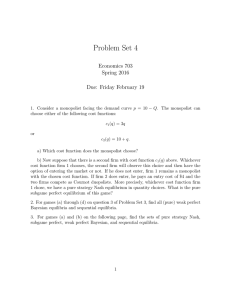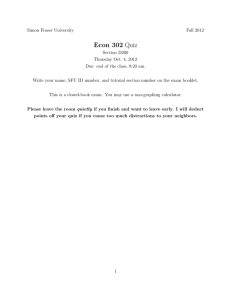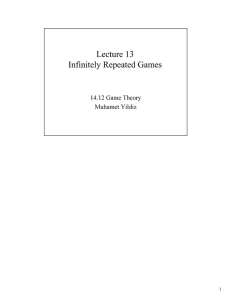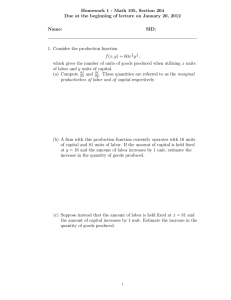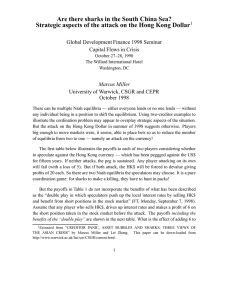Simon Fraser University Spring 2014 Econ 302 D200 Midterm Exam Instructor: Songzi Du
advertisement
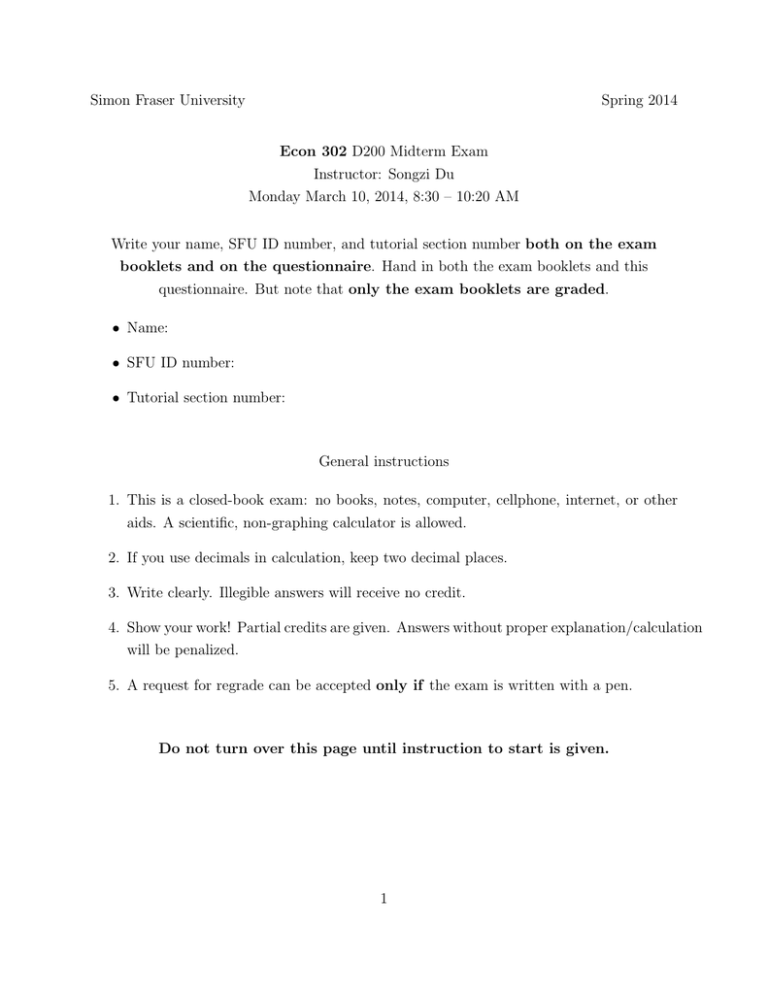
Simon Fraser University Spring 2014 Econ 302 D200 Midterm Exam Instructor: Songzi Du Monday March 10, 2014, 8:30 – 10:20 AM Write your name, SFU ID number, and tutorial section number both on the exam booklets and on the questionnaire. Hand in both the exam booklets and this questionnaire. But note that only the exam booklets are graded. • Name: • SFU ID number: • Tutorial section number: General instructions 1. This is a closed-book exam: no books, notes, computer, cellphone, internet, or other aids. A scientific, non-graphing calculator is allowed. 2. If you use decimals in calculation, keep two decimal places. 3. Write clearly. Illegible answers will receive no credit. 4. Show your work! Partial credits are given. Answers without proper explanation/calculation will be penalized. 5. A request for regrade can be accepted only if the exam is written with a pen. Do not turn over this page until instruction to start is given. 1 1. (10 points) Consider the following game. W X Y Z A 2, 1 0, 3 2, 0 2, 0 B 1, 2 3, 1 1, 1 2, 1 C 1, 4 1, 0 4, 3 3, 3 D 0, 1 2, 1 2, 3 4, 0 Part i: Find the strategies that survive iterative deletion of strictly dominated strategies (ISD). For each strategy that you delete, write down the strategy that strictly dominates it. Part ii: Find all Nash equilibria (pure and mixed) in this game, and for each Nash equilibrium that you find, calculate the two players’ expected payoffs in the equilibrium. 2. (10 points) Find and describe the pure-strategy subgame perfect equilibria (SPE) in the following game. Explain the steps that you use to find the SPE. (This is a three-player game: the payoffs of (1, 3, 1) (given by actions a, d and f ) mean that player 1 gets 1, player 2 gets 3, and player 3 gets 1.) 1 a c b 2 2 e d 3 2 3 d0 e d 3 3 e0 3 3 0 g 2 0 0 f g f g f g f g f 1 3 1 3 0 0 3 0 0 1 1 3 0 1 1 1 3 2 1 2 3 0 1 1 −1 1 1 0 f 00 g 00 0 1 0 2 0 1 3. (10 points) The market demand function for a monopolist’s product is P (q) = 20 − q. The monopolist’s cost function is C(q) = 2q 2 , where C(q) is the cost to produce q units of the product. Assume that the government imposes a sales tax of 50%, and the sales tax does not impact the monopolist’s cost. Calculate the monopolist’s price and quantity, and calculate the corresponding consumer’s price. 2 4. (10 points) Consider a market setting with three firms. Firm 2 and 3 are already operating as monopolists in two different industries (they are not competitors). Firm 1 must decide whether to enter firm 2’s industry and thus compete with firm 2, or enter firm 3’s industry and thus compete with firm 3. Production in firm 2’s industry occurs at zero cost, whereas the cost of production in firm 3’s industry is 2 per unit. Demand in firm 2’s industry is given by p = 9 − Q, whereas demand in firm 3’s industry is given by p0 = 14 − Q0 , where p and Q denote the price and total quantity in firm 2’s industry and p0 and Q0 denote the price and total quantity in firm 3’s industry. The game runs as follows: First, firm 1 chooses between E 2 and E 3 . (E 2 means “enter firm 2’s industry” and E 3 means “enter firm 3’s industry.”) This choice is observed by firm 2 and 3. Then, if firm 1 chooses E 2 , firm 1 and 2 competes in quantity (simultaneously setting their production quantities q1 and q2 ); in this case firm 3 is the monopolist in his industry. On the other hand, if firm 1 chooses E 3 , then firm 1 and 3 competes in quantity (simultaneously setting their production quantities q10 and q30 ); in this case firm 2 is the monopolist in his industry. Calculate and report the subgame perfect equilibrium (SPE) of this game. Note that the SPE involves the strategies of all three firms. 5. (10 points) The following (stage) game is repeated twice: L M R U 8, 8 0, 9 0, 0 C 9, 0 0, 0 3, 1 D 0, 0 1, 3 3, 3 In each stage the two players move simultaneously, and in the second stage the players observe the actions taken in the previous stage. Assume that the final payoff of a player is the sum of his payoffs from the two stages. Find and describe a subgame perfect equilibrium (SPE) in which (U, L) is played in the first stage. Explain why it is a SPE. 6. (10 points) Player 1 and player 2 simultaneously make demands m1 and m2 , where m1 and m2 are real numbers between 0 and 1. If m1 + m2 ≤ 1 (compatible demands, given that the surplus to be divided equals 1), then player 1 obtains the payoff m1 and player 2 3 obtains m2 . On the other hand, if m1 + m2 > 1 (incompatible demands), then both players get 0. Find and describe all pure-strategy Nash equilibria of this game. Explain your answer. 4
